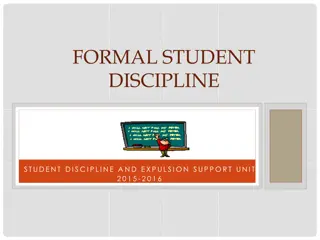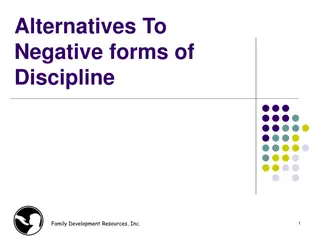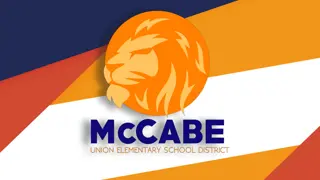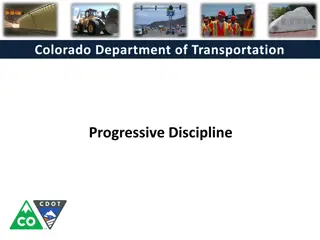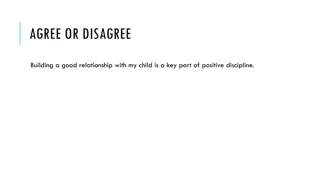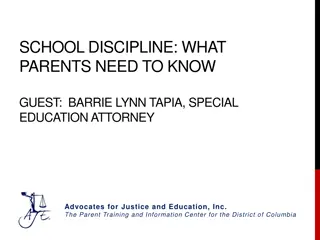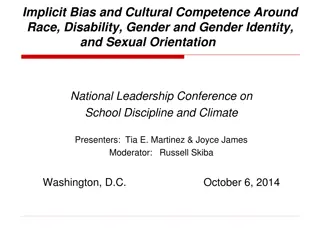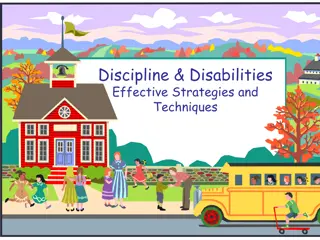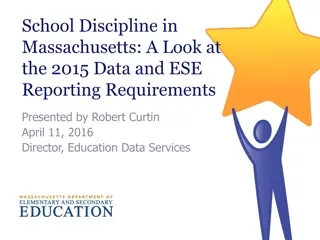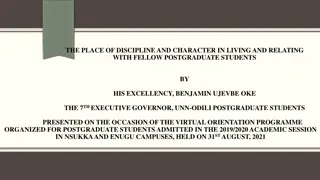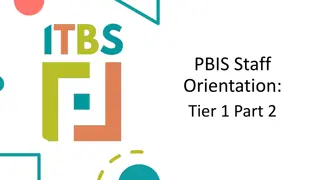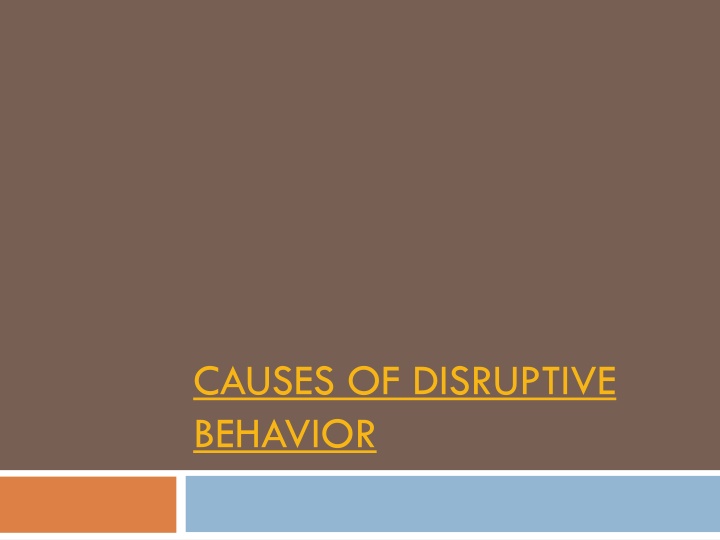
Addressing Disruptive Classroom Behaviors
Explore key learnings and strategies for tackling disruptive behaviors in the classroom, including causes, disciplinary approaches, and small disruptions. Discover effective techniques to manage student conduct and create a positive learning environment.
Download Presentation

Please find below an Image/Link to download the presentation.
The content on the website is provided AS IS for your information and personal use only. It may not be sold, licensed, or shared on other websites without obtaining consent from the author. If you encounter any issues during the download, it is possible that the publisher has removed the file from their server.
You are allowed to download the files provided on this website for personal or commercial use, subject to the condition that they are used lawfully. All files are the property of their respective owners.
The content on the website is provided AS IS for your information and personal use only. It may not be sold, licensed, or shared on other websites without obtaining consent from the author.
E N D
Presentation Transcript
CAUSES OF DISRUPTIVE BEHAVIOR
Key Learnings About Discipline at WES We need a consistent, school-wide plan for responding to discipline. At times, it appears that the students run the school instead of adults. Responses to disciplinary calls were slow or not at all. Staff concerned about consequences issued for student infractions. A large number of children were disruptive and disrespectful without any adults being able to stop the behavior. Frustration
Session Objectives Identify and define causes of disruptive and inattentive behaviors and analyze which ones are at work your classroom. Improve teacher skill at delivering effective responses to the most common causes. Leave with at least one new specific technique to apply.
Grants Key Beliefs About Discipline Discipline is the responsibility of every member of the WES Family. We need Team 100% to establish a safe and orderly learning environment. Discipline begins in the classroom and radiates out to the building.
What do I have to do to get students to apply themselves to their work and stop fooling around and being disruptive?
Todays Agenda Review Agenda Causes of Classroom Disruptions Break Lunch The Winterfield Way Decision about next steps Closure (3-2-1)
My Biggest Concern Please write down your biggest concern and questions about managing student behavior on a post-it note. The answers are in the room: Greet a friend Share your concern Listen to advice Reverse Repeat 3 times.
Power Revenge Avoidance of Failure Attention Goals of Disruptive Behavior
Its the Small Stuff Disruptions due to goofing off and taking a break from work: Talking to a neighbor (roughly 80%) Out of seat disruptions (15%) Nickel and Dime disruptions: Pencil tapping Note passing Playing with an object smuggled into class Remaining 5%
Assumptions About Discipline All behavior has an origin or cause. There are at least 13 causes of inattentive or disruptive behavior. Effective responses to disruptive behavior are chosen from a repertoire to match the cause or causes. Every one of us has the capacity to understand and respond effectively to the discipline problems we face. 1. 2. 3. 4.
Assumptions About Discipline Effective discipline is built on a comprehensive strategy of: Sound classroom management, sound instructional design & delivery, and building relationships with students Establishing and maintaining authority by communicating expectations and limit setting Responding to and eliminating misbehavior Building a strong classroom climate that nurtures cooperation, responsibility, and self-discipline
Causes of Disruptive or Inattentive Behavior
Categories of Causes Classroom Management & Instruction (1-4) Expectations (5-6) Student Values and Interests (7-8) Physical and Emotional Conditions (9-13)
#1-4: Foundational 90% of all major discipline issues can be handled by establishing strong foundations: Management Relationships Instruction
#1-Poor General Management Basic areas of classroom operation that often need: Reassessing Revisiting Refining Space Time (Pacing) Routines Attention Momentum Discipline Foundations for Good Behavior
The Foundations for Good Behavior Inattention to or mismanagement of Attention, Momentum, Time, Space, and Routines can leave students: Distracted Frustrated Bored and tuned out Downtime on their hands
How do I get the most out of my space and furniture? Space The best room arrangement: Puts the least distance between the teacher and any student in the class Visual range? Allows the teacher to get from any student to any other student in the fewest possible steps Matches the instructional objectives Minimizes empty furniture (it absorbs energy) Is your room neat, inviting, presentable?
How do I time events and regulate schedules so that students get the most productive learning time? Time Downtime, delays, and distractions Reasonable time allocations? Processing Time Movement Time Wait Time
What do/will the first 10 minutes of your class look like? Feel like?
What procedural routines are important, and how do I get maximum mileage out of them? Routines Routines tell students how to do the routinely occurring tasks in the classroom and school.
What procedural routines are important, and how do I get maximum mileage out of them? Routines Routines tell students how to do the routinely occurring tasks in the classroom and school. Entering class Beginning the day Taking attendance Returning from absences Distributing or collecting materials Turning in work Dealing with broken or missing supplies Leaving the classroom Speaking in large group Asking for and receiving help Making transitions What to do when work is finished
How do I get students to pay attention and stay on task? Attention Bellwether: someone or something that leads others or shows what will happen in the future Children are often criticized for not paying attention. There is no such thing as not paying attention; the brain is always paying attention to something. What we really mean is that the child or student is not paying attention to what we think is relevant or important. Attention, as all of us know, is selective. Patricia Wolf (2001, p. 80)
How do I get students to pay attention and stay on task? Attention According to Eric Jensen the brain Is designed to selectively attend to stimuli and has a built in bias for certain types of stimuli Novelty or contrast to the familiar Intensity of the stimuli Movement Emotion What is your repertoire of ways to capture the brain s attention?
How do I get students to pay attention and stay on task? Attention To get students to attend, students need : Why something is important? Is it relevant to me? Is it worth my attention? What is your repertoire of ways to capture the brain s attention?
Attention Strategies Present information using multiple modalities (auditory, visual, kinetic and kinesthetic) Induce emotional state changes Calm (predictable routines-openings, closings, greetings) Energize-introduce novel Use humor to draw students into your mood Level of challenge
Processing Time: 10-2 Rule Information Input Processing Time 10 Minutes 2 Minutes Lecture Video Discussion Speak Write Draw
Movement Time: 20-90 Rule Information Input Up & About Time 20 Minutes 90 Seconds Lecture Video Discussion Partner Share Carousel Room Tour
Attention Summary Use a range of auditory, visual, and kinesthetic explanatory devices when presenting information. Pay attention to the feeling tone of the learning experience and the mood of the students-adjust 10-2 20-90 Laugh and pay attention to the emotional climate of your classroom.
Attention Winning: Moves are positive & tend to attract rather than force students attention to the learning experience. Acknowledging: Acknowledge (out loud) your understanding of the distraction or what s on their mind to enable them to pay attention in class. Enlisting: Intended to captivate students and sweep them away in the interest or excitement of the activity. Alerting: Keep students on their toes. Desisting: Stop what you are doing and shift your attention elsewhere.
Desisting-24 moves Purpose: Stop what you are doing and shift your attention elsewhere. Ways of telling students they are doing something you want them to stop doing. Silent and subtle to forceful. Apply the Law of Least Resistance: use only the degree of directness and force warranted to reengage the student AND maintain a calm disposition while delivering the message. Public or private?
Noticing Examine the 24 desisting moves. What do you notice about them? What is the possible impact of desisting moves?
Alerting-13 moves Purpose: Keep students on their toes, minimize distraction and attention dropout and maximize participation and engagement. Least to Most forceful.
Noticing Examine the 13 alerting moves. What do you notice about them? What is the possible impact of alerting moves?
Enlisting-9 moves Purpose: Enlist or sign up students voluntary engagement. Intended to captivate students and sweep them away in the interest and excitement of an activity.
Noticing Examine the 9 moves. What do you notice about them? What is the possible impact of enlisting moves?
Acknowledging Purpose: Letting an inattentive student know that you care about what is on their mind. Noticing what is going on with a child Acknowledging the feeling the child is experiencing.
Winning-5 moves Purpose: Attract rather than force student attention. More about focusing on the teacher vs. the activity.
How do I get students to pay attention and stay on task? Attention Desisting: Attention moves to STOP misbehavior Alerting: Let kids know they are misbehaving Enlisting: Getting students to participate Acknowledging: Letting students know you care Proximity Touch Offer help Name Dropping Pause & Look Signals Flattery Remind Urge Freedom from distraction Eye contact Wait-time Circulation Random order Equal opportunity Incomplete sentences Looking at one, talking to another Unison Pre-Alert Redirecting/Partial answer Using student name in instructional example Startle Connecting with student s fantasies Personification Props Making student a helper Challenge Suspense Piquing student s curiosity Gesture Voice variety Dramatizing Humor Praise Enthusiasm Encouragement Offer Choice Remove Distraction I Message Move Seat Peer Competition Bringing in group pressure Private Desist General Verbal Desist Specific Verbal Desist Order Judgmental Reprimand Saracasm Threaten w/consequence Exclude Punish How many strategies are you using?
Reflection Which strategies are you willing to try this year? Share with an accountability partner. Write a post card-This year, I will try to maintain a strong classroom climate.
How do I keep the flow of events moving smoothly and minimize downtime, delays, and distractions? Momentum Provisioning: having things ready to go space and materials. What do you do to make sure everything is ready to go for all parts of your lessons?
How do I keep the flow of events moving smoothly and minimize downtime, delays, and distractions? Momentum Overlap: the ability to manage two or more parallel events simultaneously with evidence of attention to both. Are you in touch with what is going on in different groups, activities or areas? Making moves to help students over blockages Students are confused Conflict Attention issues Withitness is the precursor to overlapping.
How do I keep the flow of events moving smoothly and minimize downtime, delays, and distractions? Momentum Fillers: What teachers do when they are caught with groups of students for short periods where nothing is planned.
How do I keep the flow of events moving smoothly and minimize downtime, delays, and distractions? Momentum Manage Intrusions: Every intrusion has the potential to disrupt momentum. 1 2 3 4 Allow intrusions to fracture momentum. Deal with intrusions in a uniform way (don t tolerate intrusions or refer intruders to peers or have intruders wait for your help). Deals w/intrusions in a variety of ways at different times. Matches their response to the characteristics of the students involved.
How do I keep the flow of events moving smoothly and minimize downtime, delays, and distractions? Momentum Lesson Flexibility: What do you do when lessons or planned activities are bombing? 1 2 3 4 Press on with the lesson anyway. Drop the lesson and switch to something else. Keep the objective and try to teach it another way, or vary the format of the lesson. Match a new format to the needs of the group, or adjust it for characteristics of individuals.
How do I keep the flow of events moving smoothly and minimize downtime, delays, and distractions? Momentum Give Advanced Notice: Soften transitions by giving advanced notice of when a transition is coming. Regular transition signal/song Digital/Smart board timer Verbal: Two more minutes until
How do I keep the flow of events moving smoothly and minimize downtime, delays, and distractions? Momentum Subdividing:Anticipating potential traffic jams when transitioning students between activities.
How do I keep the flow of events moving smoothly and minimize downtime, delays, and distractions? Momentum Anticipation: Anticipate trouble spots incidents that will break momentum and make moves to sidestep them.
How do I keep the flow of events moving smoothly and minimize downtime, delays, and distractions? Momentum Provision: Have equipment and materials out and ready to go. Overlap: Radar monitoring more than one event simultaneously. Fillers: Brief activities ready for unexpected or unanticipated down time. Manage Intrusions: Minimize disruptions Lesson Flexibility: Modifying the bombing lesson Give Advance Notice: Prior to transitions: In 3 minutes be ready to Subdivide: Move the masses in smaller units to avoid bottlenecks Anticipate blocks: Thinking ahead to what could go wrong
#2-Inappropriate Work The work is: Too easy or Too difficult

